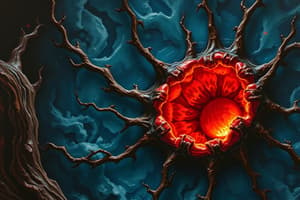Podcast
Questions and Answers
What is the primary difference between apoptosis and necrosis?
What is the primary difference between apoptosis and necrosis?
Apoptosis is programmed cell death, while necrosis is unregulated cell death in response to external factors such as toxins, trauma, and infection.
What is the result of oxygen deprivation in cells, and what are some possible causes of this condition?
What is the result of oxygen deprivation in cells, and what are some possible causes of this condition?
Oxygen deprivation, or hypoxia, can result in a reduction in aerobic oxidative respiration, leading to cellular injury or death. Possible causes include reduced blood flow, inadequate oxygenation of the blood, and decreased blood oxygen-carrying capacity.
What is the effect of cellular swelling on ion concentrations and water influx?
What is the effect of cellular swelling on ion concentrations and water influx?
Cellular swelling causes changes in ion concentrations and water influx, leading to a depletion of energy stores in the form of adenosine triphosphate (ATP).
What is the process by which intracellular components, including organelles, are packaged into miniature membrane pockets?
What is the process by which intracellular components, including organelles, are packaged into miniature membrane pockets?
What type of necrosis is typically caused by ischemia or infarction and tends to occur in tissues such as the heart, kidney, and adrenal glands?
What type of necrosis is typically caused by ischemia or infarction and tends to occur in tissues such as the heart, kidney, and adrenal glands?
What are some examples of physical agents that can cause cellular injury?
What are some examples of physical agents that can cause cellular injury?
What are the primary differences between necrotic cell death and apoptotic cell death?
What are the primary differences between necrotic cell death and apoptotic cell death?
What is the result of the denaturation of intracellular proteins and enzymatic digestion in necrotic cells?
What is the result of the denaturation of intracellular proteins and enzymatic digestion in necrotic cells?
What is the role of pro-inflammatory macrophages in necrotic cell death?
What is the role of pro-inflammatory macrophages in necrotic cell death?
What is the condition that occurs when a person experiences an injury to an area of fatty tissue, resulting in the fat being replaced with the oily contents of fat cells?
What is the condition that occurs when a person experiences an injury to an area of fatty tissue, resulting in the fat being replaced with the oily contents of fat cells?
What is the effect of ischemia on cellular injury and death?
What is the effect of ischemia on cellular injury and death?
What is the term for the death of tissue due to a lack of blood flow?
What is the term for the death of tissue due to a lack of blood flow?
What are some nuclear changes that occur during apoptotic cell death?
What are some nuclear changes that occur during apoptotic cell death?
What is the process by which phagocytes engulf and degrade apoptotic bodies?
What is the process by which phagocytes engulf and degrade apoptotic bodies?
What is the type of necrosis that involves the transformation of cellular mass into a liquid viscous mass, commonly associated with bacterial and fungal infections?
What is the type of necrosis that involves the transformation of cellular mass into a liquid viscous mass, commonly associated with bacterial and fungal infections?
What is the term for the morphologic appearance of necrosis resulting from denaturation of intracellular proteins and enzymatic digestion?
What is the term for the morphologic appearance of necrosis resulting from denaturation of intracellular proteins and enzymatic digestion?
What is the earliest histologic evidence of necrosis, and how long does it take to become apparent?
What is the earliest histologic evidence of necrosis, and how long does it take to become apparent?
What is the characteristic appearance of cytoplasm in necrotic cells, and what is the cause of this change?
What is the characteristic appearance of cytoplasm in necrotic cells, and what is the cause of this change?
What are myelin figures, and how do they form in necrotic cells?
What are myelin figures, and how do they form in necrotic cells?
What is the outcome of karyolysis, and what is the underlying mechanism?
What is the outcome of karyolysis, and what is the underlying mechanism?
What is the effect of mitochondrial damage on oxidative phosphorylation in coagulative necrosis?
What is the effect of mitochondrial damage on oxidative phosphorylation in coagulative necrosis?
What is the role of anaerobic glycolysis in coagulative necrosis, and how does it contribute to cellular damage?
What is the role of anaerobic glycolysis in coagulative necrosis, and how does it contribute to cellular damage?
What is the effect of ischemia on cellular swelling, and what is the underlying mechanism?
What is the effect of ischemia on cellular swelling, and what is the underlying mechanism?
What is the outcome of karyorrhexis, and what is the characteristic feature of this nuclear change?
What is the outcome of karyorrhexis, and what is the characteristic feature of this nuclear change?
What is the eventual outcome of the breakdown of membranes, cytoskeletal proteins, and genomic and mitochondrial DNA?
What is the eventual outcome of the breakdown of membranes, cytoskeletal proteins, and genomic and mitochondrial DNA?
What is the role of caspase 9 in the intrinsic apoptotic pathway?
What is the role of caspase 9 in the intrinsic apoptotic pathway?
What is the significance of apoptosis during the development of an embryo?
What is the significance of apoptosis during the development of an embryo?
What is the effect of ischemia on cellular injury and death?
What is the effect of ischemia on cellular injury and death?
What is the outcome of cellular swelling due to an increase in ion concentrations and water influx?
What is the outcome of cellular swelling due to an increase in ion concentrations and water influx?
What is the characteristic feature of nuclear changes during apoptotic cell death?
What is the characteristic feature of nuclear changes during apoptotic cell death?
What is the role of initiator caspases in the apoptotic pathway?
What is the role of initiator caspases in the apoptotic pathway?
What is the significance of apoptosis in adult humans?
What is the significance of apoptosis in adult humans?
What is the mechanism by which cytochrome C is released from the mitochondrial membrane during apoptosis?
What is the mechanism by which cytochrome C is released from the mitochondrial membrane during apoptosis?
What is the role of Apaf-1 in the formation of the Apoptosome?
What is the role of Apaf-1 in the formation of the Apoptosome?
What is the function of caspase 3 in the execution phase of apoptosis?
What is the function of caspase 3 in the execution phase of apoptosis?
What is the role of Gelsolin in the execution phase of apoptosis?
What is the role of Gelsolin in the execution phase of apoptosis?
What is the consequence of cardiolipin oxidation on cytochrome C binding?
What is the consequence of cardiolipin oxidation on cytochrome C binding?
What is the role of IAPs in regulating the apoptotic signal?
What is the role of IAPs in regulating the apoptotic signal?
What is the consequence of cytochrome C binding to Apaf-1?
What is the consequence of cytochrome C binding to Apaf-1?
What is the role of procaspase 9 in the formation of the Apoptosome?
What is the role of procaspase 9 in the formation of the Apoptosome?
What is the function of caspase 9 in the intrinsic apoptotic pathway?
What is the function of caspase 9 in the intrinsic apoptotic pathway?
What is the outcome of DNA fragmentation during apoptosis?
What is the outcome of DNA fragmentation during apoptosis?
What is the role of initiator caspases in the apoptotic pathway?
What is the role of initiator caspases in the apoptotic pathway?
What is the result of cytoskeletal reorganization during apoptosis?
What is the result of cytoskeletal reorganization during apoptosis?
What is the role of cytochrome C in the intrinsic apoptotic pathway?
What is the role of cytochrome C in the intrinsic apoptotic pathway?
What is the outcome of Apoptosome formation?
What is the outcome of Apoptosome formation?
What is the function of caspase 3?
What is the function of caspase 3?
What is the role of procaspase 9 in the formation of the Apoptosome?
What is the role of procaspase 9 in the formation of the Apoptosome?
What is the primary function of caspase 7 in the apoptotic pathway?
What is the primary function of caspase 7 in the apoptotic pathway?
What is the result of poly(ADP-ribose) polymerase (PARP) cleavage?
What is the result of poly(ADP-ribose) polymerase (PARP) cleavage?
Which protein is cleaved by caspase 3 in the execution phase of apoptosis?
Which protein is cleaved by caspase 3 in the execution phase of apoptosis?
What is the role of FADD in the extrinsic apoptotic pathway?
What is the role of FADD in the extrinsic apoptotic pathway?
What is the function of TRADD in the TNF receptor-mediated apoptotic pathway?
What is the function of TRADD in the TNF receptor-mediated apoptotic pathway?
What is the role of Bax and Bak in the intrinsic apoptotic pathway?
What is the role of Bax and Bak in the intrinsic apoptotic pathway?
What is the result of the binding of Fas ligand to the Fas receptor?
What is the result of the binding of Fas ligand to the Fas receptor?
What is the primary effect of chromatin condensation during apoptotic cell death?
What is the primary effect of chromatin condensation during apoptotic cell death?
What is the role of Apaf-1 in the intrinsic apoptotic pathway?
What is the role of Apaf-1 in the intrinsic apoptotic pathway?
What is the typical size of DNA fragments resulting from DNA cleavage during apoptosis?
What is the typical size of DNA fragments resulting from DNA cleavage during apoptosis?
What is the primary role of caspase 3 in the apoptotic pathway?
What is the primary role of caspase 3 in the apoptotic pathway?
What is the effect of cytoskeletal reorganization during apoptosis?
What is the effect of cytoskeletal reorganization during apoptosis?
What is the role of Apaf-1 in the apoptotic pathway?
What is the role of Apaf-1 in the apoptotic pathway?
What is the consequence of procaspase 9 activation during apoptosis?
What is the consequence of procaspase 9 activation during apoptosis?
What is the role of gelsolin in the apoptotic pathway?
What is the role of gelsolin in the apoptotic pathway?
What is the consequence of cardiolipin oxidation during apoptosis?
What is the consequence of cardiolipin oxidation during apoptosis?
What is the role of cardiolipin oxidation in apoptotic signaling?
What is the role of cardiolipin oxidation in apoptotic signaling?
What is the primary function of caspase 3 in the execution phase of apoptosis?
What is the primary function of caspase 3 in the execution phase of apoptosis?
What is the role of Apaf-1 in the intrinsic apoptotic pathway?
What is the role of Apaf-1 in the intrinsic apoptotic pathway?
What is the consequence of cytochrome C binding to Apaf-1?
What is the consequence of cytochrome C binding to Apaf-1?
What is the role of Gelsolin in the execution phase of apoptosis?
What is the role of Gelsolin in the execution phase of apoptosis?
What is the role of IAPs in regulating the apoptotic signal?
What is the role of IAPs in regulating the apoptotic signal?
What is the consequence of procaspase 9 activation?
What is the consequence of procaspase 9 activation?
What is the role of caspase 9 in the intrinsic apoptotic pathway?
What is the role of caspase 9 in the intrinsic apoptotic pathway?
What is the term for the transformation of cellular mass into a liquid viscous mass commonly associated with bacterial and fungal infections?
What is the term for the transformation of cellular mass into a liquid viscous mass commonly associated with bacterial and fungal infections?
What is the process by which intracellular components, including organelles, are packaged into miniature membrane pockets called apoptotic bodies?
What is the process by which intracellular components, including organelles, are packaged into miniature membrane pockets called apoptotic bodies?
What is the term for the death of tissue due to a lack of blood flow?
What is the term for the death of tissue due to a lack of blood flow?
What is the outcome of the denaturation of intracellular proteins and enzymatic digestion in necrotic cells?
What is the outcome of the denaturation of intracellular proteins and enzymatic digestion in necrotic cells?
What is the condition that occurs when a person experiences an injury to an area of fatty tissue, resulting in the fat being replaced with the oily contents of fat cells?
What is the condition that occurs when a person experiences an injury to an area of fatty tissue, resulting in the fat being replaced with the oily contents of fat cells?
What is the term for the morphologic appearance of necrosis resulting from denaturation of intracellular proteins and enzymatic digestion?
What is the term for the morphologic appearance of necrosis resulting from denaturation of intracellular proteins and enzymatic digestion?
What is the process by which phagocytes engulf and degrade apoptotic bodies?
What is the process by which phagocytes engulf and degrade apoptotic bodies?
What is the term for a type of necrosis characterized by accumulation of amorphous, basic, proteinaceous material in the tissue matrix?
What is the term for a type of necrosis characterized by accumulation of amorphous, basic, proteinaceous material in the tissue matrix?
What are the 2 main categories of Caspases?
What are the 2 main categories of Caspases?
What are the exact initiator caspases?
What are the exact initiator caspases?
What is the role of initiator caspases in the cell?
What is the role of initiator caspases in the cell?
What are the roles of Executioner caspases?
What are the roles of Executioner caspases?
What is the main characteristic of the Extrinsic Death receptor mediated pathway?
What is the main characteristic of the Extrinsic Death receptor mediated pathway?
What is the primary mechanism of the intrinsic - mitochondria mediated pathway of apoptosis?
What is the primary mechanism of the intrinsic - mitochondria mediated pathway of apoptosis?
What are the key proteins involved in the Intrinsic Mitochondria Mediated pathway?
What are the key proteins involved in the Intrinsic Mitochondria Mediated pathway?
Which Bcl-2 family proteins are involved in the intrinsic - mitochondria mediated pathway?
Which Bcl-2 family proteins are involved in the intrinsic - mitochondria mediated pathway?
Flashcards are hidden until you start studying
Study Notes
Apoptosis and Necrosis
- Apoptosis: programmed cell death, a tightly regulated suicide program controlled by specific genes
- Necrosis: unregulated cell death in response to external factors such as toxins, trauma, and infection, leading to release of cellular machinery into surrounding tissues
Cellular Injury
- Caused by:
- Oxygen deprivation (hypoxia)
- Physical agents (mechanical trauma, extreme temperatures, radiation, electric shock)
- Chemical agents and drugs
- Infectious agents
- Immunologic reactions
- Genetic derangements
- Nutritional imbalances (protein-calorie and/or vitamin deficiencies, overnutrition)
Necrotic Cell Death
- Stages:
- Swelling of the endoplasmic reticulum and membrane blebing
- Plasma membrane breakdown and cell contents leak out
- Organelle breakdown and leakage of contents
- Pro-inflammatory macrophage recruitment and inflammatory response
- Release of "volatile" intracellular components, leading to damage to surrounding cells
- Neutrophil infiltration to degrade dead cells
Apoptotic Cell Death
- Stages:
- Chromatin condenses and DNA cleaves into 200 base pair units
- Membrane blebbing
- Release of cytochrome C from mitochondria into cytosol
- Formation of an Apoptosome and activation of effector caspases
- Execution phase: activation of caspase 3, cleavage of ICAD, and fragmentation of DNA
- Apoptotic bodies are engulfed by phagocytes and recycled
Types of Necrosis
- 6 types:
- Coagulative necrosis: typically caused by ischemia or infarction, occurs in tissues such as heart, kidney, and adrenal glands
- Liquefactive necrosis: involves transformation of cellular mass into a liquid viscous mass, commonly associated with bacterial and fungal infections
- Caseous necrosis: tissue maintains a cheese-like appearance, dead tissue appears as a soft and white proteinaceous dead cell mass
- Fat necrosis: occurs when a person experiences an injury to an area of fatty tissue, resulting in fat being replaced with oily contents of fat cells
- Fibrinoid necrosis: characterized by accumulation of amorphous, basic, proteinaceous material in the tissue matrix
- Gangrenous necrosis: death of tissue due to a lack of blood flow
Morphology of Necrosis
- Result of denaturation of intracellular proteins and enzymatic digestion
- Necrotic cells unable to maintain membrane integrity, leading to leakage of contents and potential inflammation in surrounding tissue
- Enzymes that digest necrotic cells derived from lysosomes of dying cells and leukocytes
- Digestion of cellular contents and host response may take hours to develop
Studying That Suits You
Use AI to generate personalized quizzes and flashcards to suit your learning preferences.




